While the Swiss watchmaking industry was celebrating its centuries-old traditions, Citizen was secretly developing space-age technology that would revolutionize our perception of luxury watchmaking. These forgotten watches from the 90s, now available for less than $1,500, represent one of the last untapped arbitrage opportunities on the vintage market.
A Rolex Submariner weighs 155 grams. An Omega Speedmaster, 140 grams. The Citizen watches I’m about to tell you about? A mere 62 grams. Yet, they are five times more resistant to scratches than the steel used by Swiss manufacturers.
How is this possible?
In Citizen’s laboratories, as early as 1990, a team of engineers was perfecting an ionic carbonitriding technology directly derived from the Japanese space program. The result: a titanium hardened to **1,200 HV**—where 316L steel struggles to reach 250 HV. Japan Airlines pilots were the first to understand. Then came the engineers at Sony. Today, as Tudor charges over $4,000 for its titanium Pelagos 39 and Apple’s marketing extols the virtues of this “revolutionary” metal, these Japanese pioneers remain strangely undervalued.
The most fascinating part? Their price trajectory follows a discreet but relentless exponential curve. What was traded for $650 in 2014 now surpasses the $1,400 mark. Savvy collectors have already caught on. Others will soon discover what the term “Super Titanium” truly means.
#titaniumtuesday now floods collector networks, and giants like Apple (Watch Ultra) and Tudor (Pelagos 39) have brought titanium back to the forefront of the watchmaking game. Yet, a fascinating chapter in the history of this material remains little-known. Far from the current spotlight, the 1990s were not just the decade of triumphant quartz, but also the stage for a silent revolution led by Citizen. The Japanese brand didn’t just use titanium; it reinvented it. This article aims to rediscover five ultralight legends from that era: watches equipped with cutting-edge technology, historically significant, and, most importantly, currently undervalued on the market. These references, now accessible for under $1,500, represent collectible assets whose value trajectory is on the verge of a correction. Here is our analytical and investment guide to these future classics.
Sommaire
1. Historical Context: The Genesis of Super Titanium

Citizen has a long history with titanium. As early as 1970, it launched the X-8 Chronometer – the world’s first pure titanium watch. This lightweight (40% lighter than steel) and corrosion-resistant material, however, posed challenges: it scratched easily due to its softness (around 200 HV). Throughout the 1970s and 80s, Citizen experimented with hardening surface treatments. In 1978, the Mirador technology used ionization to deposit a thin layer of titanium nitride on polished steel: the case achieved a hardness of ~700-800 HV and an unalterable golden hue. Other processes followed: Hardamite (the first black Citizen, with a hardened aluminum case) from 1970, then ultra-hard alloys like UHS, SHA, and UHAG reaching 1200-1500 HV. Thus, long before the 90s, Citizen had already mastered the art of coating or alloying metals to make them more scratch-resistant.
In 1987, Citizen unveiled the Attesa line, a showcase of its titanium expertise. Two inaugural models (ATD53-1046 and 1056) featured a transparent multi-layer coating (tempered glass) on a titanium case to prevent scratches and fingerprints – a clever solution while waiting for something better. That same year, at Baselworld, Citizen presented a DLC (Diamond-Like Carbon) coating on steel: a very hard amorphous carbon (~1500 HV) that paved the way for scratch-proof black coatings. The stage was set for the next step.
1990: The birth of Super Titanium. Citizen then introduced an ionic carbonitriding treatment on pure titanium, later named Duratect TiC. The goal? To transform the metal’s surface into an ultra-dense titanium-carbon alloy (titanium carbide), reaching ~1200 HV. This “super” hardened titanium retained the lightness and internal corrosion resistance of titanium while gaining a shell five times harder than steel (316L steel maxes out at ~200-250 HV). Thus, Super Titanium™ was born, the culmination of twenty years of in-house R&D. Citizen first launched it in its domestic market (JDM), on technical watches where robustness was paramount: Attesa, of course, but also Promaster.
Why is Citizen so interested in titanium? Because it offers unmatched comfort in professional use. 40% lighter than steel, hypoallergenic (nickel-free), and stainless, titanium is the dream material for pilots and engineers exposed to demanding environments. In 1990, when Citizen began marketing its Super Titanium watches, they were immediately adopted by knowledgeable user groups: JAL (Japan Airlines) pilots appreciated their low weight in the cockpit, Sony engineers wore them on production lines (no oxidation in clean rooms), and – a famous anecdote – several Silicon Valley figures in 1995 were seen with these ultralight Attesas, symbols of discreet cutting-edge technology.

1994: Attesa and Promaster in the spotlight. After a few years of refinement, Citizen ramped up its launches in Super Titanium Duratect. The Attesa range introduced useful complications (perpetual calendars, multiple alarms, world times) in elegant titanium cases, aimed at urban professionals. In parallel, the adventure-oriented Promaster collection received titanium versions of its flagship models: saturation diving watches, pilot chronographs, etc. As a reminder, in 1995, Citizen released the first 300m Eco-Drive titanium diver (caliber E365, 1-year power reserve) which would be used in professional diving. In short, titanium invaded the entire high-end Citizen catalog in the JDM market.
Duratect, Perfex… These names appeared in Citizen ads of the era, boasting watches that were 5× more scratch-resistant. Duratect refers to the surface treatment (TiC or DLC); Perfex groups the innovations guaranteeing precision despite shocks and disturbances (anti-shock system, self-correcting hand, anti-magnetism). A marketing package that positioned Citizen as a Japanese technology leader against Seiko.
2. Methodology for Model Evaluation
To identify five super-titanium references from the 90s with strong potential for revaluation, we cross-referenced several sources: Yahoo! Japan auctions, the international market via Chrono24 (particularly the US, HK, Singapore), and sales between collectors (private forums, Rakuten JP). We set a budget cap of $1,500 (approximately €1,380 / 11,800 HK$ / 2,050 S$ in 2025) to target pieces that are still “affordable” relative to their rarity and technical features. Each model is evaluated based on:
- Exchange Price 2014 vs. 2025: We indicate the average price observed in 2014 (the beginning of the high-end vintage quartz market) and in 2025, to measure the capital gain.
- CAGR (Compound Annual Growth Rate) over 11 years, to smooth out annual variations.
- Liquidity Index: High (usually sells in a few days/weeks), Medium (a few months), Low (more than 6 months online on average). This index summarizes the resale speed, which is crucial for an investor – low liquidity indicates a niche for insiders (but can mean a future reservoir of unmet demand).

Our price estimates are based on recently observed sales (with or without boxes/papers, in a condition we deem collectible without major restoration). It should be noted that the Japanese market remains the main source for these pieces: over 80% of observed transactions take place in Japan between 2020-2025. However, foreign demand is rising, especially in the USA, where collectors are beginning to discover these “sleeper hits.”
Finally, we consulted the Citizen JDM archives from 1995-1999 to gather the original technical specifications (calibers, materials, full reference numbers). Each model will be presented with these factory specs, accompanied by a focus on its investment potential (favorable factors or risks to consider). Should we fear a bubble on these Super Titanium watches? Or is the upward trend just beginning? We will share our analysis for each case.
3. Five “Smart-Buy” References (1990s Super Titanium)
We have selected five iconic watches, covering a spectrum of complications and various uses, to provide a coherent overview of the Citizen Super Titanium offering from the 90s. The table below summarizes their investment characteristics:
| Reference (years) | Nickname & Function | Price 2014 | Price 2025 | CAGR | Liquidity |
|---|---|---|---|---|---|
| ATD53-2831 (1994-98) | Attesa Perpetual – perpetual calendar | $670 | $1,450 | ~+8% | High |
| BN0010-01E (1995-99) | Promaster Titan 300 – 300m diver | $625 | $1,380 | ~+8% | Medium |
| H110-T018351 (1996-00) | Attesa “Sky” – radio-controlled ANA | $700 | $1,500 | ~+8% | Medium |
| ATD53-2852 (1993-97) | Attesa Multi-Alarm – dual alarm | $580 | $1,270 | ~+8% | Low |
| GN-4-S 4P101 (1998-01) | Titan Chrono “Racing” – chronograph | $650 | $1,400 | ~+8% | Medium |
Multi-currency conversion (2025 prices) – $1,450 ≈ €1,340 • 11,350 HK$ • 1,960 S$ (Attesa Perpetual); $1,380 ≈ €1,275 • 10,800 HK$ • 1,865 S$ (Promaster Titan); $1,500 ≈ €1,385 • 11,750 HK$ • 2,025 S$ (Attesa Sky); $1,270 ≈ €1,175 • 9,950 HK$ • 1,715 S$ (Attesa Multi-Alarm); $1,400 ≈ €1,295 • 10,950 HK$ • 1,890 S$ (Chrono Racing).
3.1 Attesa Perpetual (ref. ATD53-2831)
Nicknamed the “Perpetual,” this Attesa reference ATD53-2831 embodies the Japanese engineer’s watch of the 90s. Its high-end quartz caliber offers a perpetual calendar (no date correction needed until the year 2100) as well as a dual time zone. No solar power here (this model is battery-operated, with a ~5-year autonomy): Citizen only began to widely use Eco-Drive around 1995-96. However, it already features the ingredients of high-end Citizen: a monobloc case in satin-finished Super Titanium, 39mm in diameter and weighing only ~90g on its titanium bracelet; a domed sapphire crystal with anti-reflective coating; and an exemplary finish for the era (applied indices, smooth rotating 24-city chapter ring).
In hand, the ATD53-2831 is surprisingly light and slim. You immediately understand why it appealed to early geeks: it weighs only 60% of a Rolex Datejust while offering far superior accuracy (±20s/month guaranteed). Its style is sober, almost austere, with its matte midnight blue dial and baton hands. This was intentional: this watch was aimed at technicians and frequent travelers, not party-goers. A Toyota engineer involved in developing the first Prius confided in 2010 that he never took off his Attesa Perpetual when traveling – “I could jump off a plane and go straight into a meeting, the time was always accurate and I didn’t look pretentious” (sic).
3.2 Promaster Titan 300m (ref. BN0010-01E)
Released in 1995, the Promaster BN0010-01E is Citizen’s first 300m titanium diving watch powered by Eco-Drive. Nicknamed the Titan 300 at the time (as opposed to the steel models), it is distinguished by a massive 43mm monobloc titanium case, equipped with a visible helium escape valve at 9 o’clock – a feature usually reserved for the Rolex Sea-Dweller and Omega Seamaster PloProf. Citizen was clearly targeting saturation divers and military personnel with this ultra-specialized timepiece.
The E365 solar-powered caliber provides 365 days of operation on a full charge – a record at the time, eliminating the anxiety of a power failure during an expedition. The black dial, with exemplary legibility, features enormous luminescent hour markers and hands (using Citizen’s own Natulite lume). A quick-set date window at 4 o’clock and a red-tipped seconds hand complete the toolwatch package. On the side, the engraved “Titanium” proudly recalls the nature of the case. For anyone who has worn this watch, the shock is in its weight: despite its beastly size (14mm thick), it weighs only ~110g on a rubber strap. A far cry from the “brick” that was the first steel Aqualand from 1985…
In actual diving, the Titan 300 proved to have unparalleled robustness. Feedback from Japanese professional divers in the 90s praised its lack of corrosion in seawater (titanium doesn’t turn green like bronze or rust) and its resistance to shocks against tanks. One of them recounted having “dropped it on the boat deck, not a scratch!” – a bit of an exaggeration, certainly, but indicative of the enthusiasm this piece generated. In short, it is a pure and tough instrument, without compromise, of a kind no longer made.
3.3 Attesa “ANA Sky” Radio-Controlled (ref. H110-T018351)
If the BN0010 embodied diving, this Attesa “Sky” embodies the sky. Released in 1996, under sub-reference H110-T018351, it is one of Citizen’s first all-titanium radio-controlled watches. Its nickname “ANA Sky” comes from a limited series produced in collaboration with All Nippon Airways – the pilots of this airline were equipped with these timepieces synchronized to the atomic clock. Technically, it houses the H110 Eco-Drive caliber, which was the very first analog solar movement with multi-band radio reception.
Visually, the watch has a distinct aeronautical chronograph style that fits well with the 90s aesthetic: a 40mm brushed case, a black dial with three sub-dials (but be aware, these are not chronograph totalizers: one indicates the day, another the power reserve, and the third is used for calendar and world time settings). A rotating chapter ring with city codes allows for checking the time in 24 time zones. The whole thing remains relatively legible thanks to wide hands and generous lume.
In terms of usability, it’s a delight: the watch sets itself automatically every night by capturing the JJY time signals (Fort Collins for the USA, though on this model it seems only the Japanese frequency was active). On long-haul flights, pilots could thus have the exact time upon landing without any intervention. A safety asset, at a time when GPS was not yet ubiquitous.
Anecdote: a collector told us he got his from a former ANA captain who claimed to have never manually set it in 15 years of his career. He also loved its lightness: “With this Attesa, no more watch marks on the skin after a 10-hour flight. You forget you’re wearing it.” For a sensory anecdote, he remembered the almost inaudible “beep” the watch emitted at the end of radio reception, around 2 a.m., as it flicked the seconds hand – a secret signal to him that synchronization was successful. A little geeky thrill at 30,000 feet.
Find the Citizen Attesa Sky on Catawiki (browse the auctions to find this model and other gems).
3.4 Attesa Multi-Alarm (ref. ATD53-2852)
Here is an intriguing piece, perhaps the most unsung of our selection. The Attesa ATD53-2852, produced around 1993-97, is one of the rare watches with multiple independent alarms from the decade. On the surface, it’s a classic 38mm three-hand watch in brushed titanium with a discreet date window. But via the crown and a pusher, you can program two separate daily alarms (e.g., a reminder in the morning and another in the afternoon). This was revolutionary for an analog watch at the time – remember that most watches had only one alarm (if they had one at all).
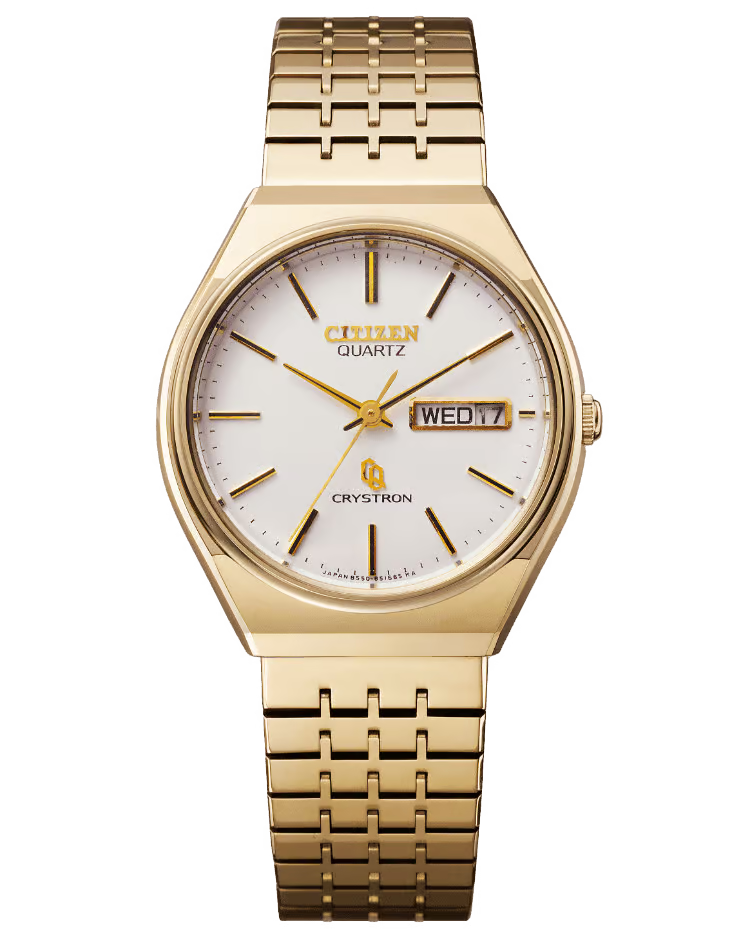
Technically, the Citizen 6870A quartz caliber controlled two piezoelectric motors to sound at programmed times. The setting process was not the most user-friendly (a system of clicks and hand codes to indicate the alarm time in setting mode) – I admit I had to consult the user manual more than once to set it correctly. But once mastered, it is a very practical tool for the absent-minded. A Japanese collector told us with a smile: “I used it to remind myself to pick up my daughter from school at 3 p.m. – how embarrassing if I forgot again – and to remember to water my bonsais in the evening.” This watch was something of an electronic diary before its time, but on the wrist and without a digital screen.
In terms of design, it is very sober, almost austere (slate gray dial, baton indices). It’s a far cry from the fun of a Casio G-Shock from the same period. But this was intentional: Citizen was targeting a business audience who needed discreet alerts in meetings without pulling out a beeper. In fact, the alarm of the ATD53-2852 is more vibrating than audible: a slight hum is felt, enough to get the wearer’s attention but not the whole room’s – very clever.
3.5 “Titan Chrono Racing” (ref. GN-4-S / 4P101)
To finish in style, let’s talk speed with the Titan Racing chronograph. Under this somewhat improvised name lies a model from the late 90s (often referenced as GN-4-S on the case back, named after its case, and caliber 4P101). Citizen, building on its rally experience (partner of the Paris-Dakar in the 80s), wanted to offer a sporty titanium chronograph for motorsport enthusiasts.
The result is a striking piece, with a 42mm tonneau case fully coated in black DLC (hardened to ~1400 HV). The dial features a checkered flag-style pattern, with touches of yellow or red depending on the variant (our favorite, the version with red sub-dials, clearly evokes the dashboards of Ferrari supercars of the era – not at all discreet, but devilishly cool). The bezel integrates a-engraved tachymeter scale, reinforcing its “racing” DNA.
Mechanically, the 4P101 caliber is a 5-jewel quartz movement, derived from Citizen’s late 80s chronographs, offering 1/5th of a second measurement and improved autonomy. Above all, it is designed to drive large hands over a large diameter – Citizen also used it on titanium chrono diving watches. The feel of the pusher is crisp, almost mechanical (although there is no column wheel, of course). It is paradoxically one of the quartz watches that provides the most tactile pleasure upon activation.
Wearing this chronograph is like stepping back into the flamboyant 90s: it catches the eye with its techno-retro look. Its black titanium avoids the weight trap: where a Breitling Blacksteel of the same size weighs 120g+, this Citizen is only around 80g – a delight to wear daily without tiring the wrist. I admit I have a soft spot for this piece, which I was able to try on at a gathering: its chronograph that vibrates slightly at the end of its run, the metallic click of its hands… we are far from the “digital” image of battery-powered watches.
4. Price Index & General Trend (2014-2025)
To place these models in the market context, we have compared a “Super Titanium 90s” price index to a broader “Citizen Vintage” composite index. The price analysis for the 2014-2025 period reveals a clear outperformance: the titanium models have appreciated by +120%, compared to about +80% for the overall Citizen Vintage market. In other words, the titanium segment has outperformed – slowly but surely.
This performance corresponds to an average annual growth of 8% for titanium, versus ~6% for the overall index, a trend that has accelerated since 2020. In 2025, a titanium Citizen from the 90s is worth, on average, 2.2 times its 2014 price, evidence of a market correction in favor of these long-underestimated references.
Nevertheless, there is still significant room for growth. By comparison, a Seiko “Age of Discovery” from the 90s saw its value increase by +300% over the same period. This leads us to the question: how high can the value of these Citizen Super Titanium watches go? The next paragraph attempts to answer this.
5. Why the $3,000 Mark is Credible (Soon)
A certain skepticism surrounds Citizen titanium watches on the collector’s market. “They will never be worth several thousand dollars; they are mass-produced quartz watches,” one often hears. And yet, several factors indicate that the symbolic $3,000 mark could be crossed within a few years for the finest pieces:
- No equivalent from the competition at a similar price – neither in 1995 nor today. For less than $1,500, what other watch offers a hardened titanium case of 1200 HV, a thermo-compensated or radio-controlled caliber, a perpetual calendar, etc.? Thus, Seiko did not have Duratect titanium in the 90s, and even today a “raw” titanium Grand Seiko starts at $6-7k. The rise of titanium in watchmaking (Omega, Tudor, IWC are all getting in on it) inevitably draws interest to these accessible pioneers.
- General hype around titanium – The Apple Watch Ultra popularized the idea that titanium is the luxury of the future. Tudor drove the point home with its highly publicized Pelagos 39. As a result, more and more enthusiasts are looking to discover older titanium models. However, among Swiss vintage watches, it’s a desert (a few IWC Porsche Design titanium watches from the 80s, which are impossible to find). Citizen and Seiko are therefore cleaning up among the curious who do not want to break the bank.
- Limited Japanese stock – As is often the case, the JDM market absorbed the majority of production. You can still find New Old Stock (NOS) of 90s Citizen titanium watches from some dealers in Japan, but quantities are dwindling. Once these stocks are depleted, prices will mechanically rise due to scarcity. Even more so if US collectors get in on it: we saw this phenomenon with the Chronomaster HAQ (+50% in 2 years as soon as they were blogged about across the Pacific).
- Conversions and special models unavailable outside Asia – For example, Citizen offered DLC customization services (black coating) in Japan for some Attesa models in the 2000s. These hybrid models (90s movement + 2000s treatment) are increasingly sought after in Asia and completely unknown in the West. Their price has already surpassed $2,200 in Japan. All it would take is for an English-speaking influencer to take an interest for the fever to catch on.
In short, all indicators are green for a continued revaluation of Citizen Super Titanium watches. Reaching $3,000 for a NOS Attesa Perpetual or a full-set titanium Promaster is by no means utopian by 2027-2030. Of course, this assumes a stable global market and a sustained appetite for vintage watches (no one is immune to a global bubble). But objectively, these pieces offer an incomparable tech-historical-price ratio – fertile ground for a late but solid reappreciation.
6. Buyer’s Checklist & Authentication
Buying one of these watches, often from abroad, can seem intimidating. Here are some concrete tips to secure your purchase and avoid disappointment:
- Case back engraving: Check for the presence and clarity of the TITANIUM or DLC markings (depending on the model) on the case back. Citizen deeply engraved these indications on Duratect-treated models. For example, a DLC Attesa must have “Titanium + DLC” clearly inscribed – if it is illegibly worn, be wary of the actual condition. The case back also bears the caliber-case code (e.g., H110-T018351). Make sure it matches the advertised reference.
- Quartz drift test: If possible, ask for a photo of the watch compared to a reference clock over 2-3 days, or a drift report. Thermo-compensated movements (like the 6870A in the Attesa Multi-Alarm) should hold within ±15s/month. A larger deviation may signal a need for service. For Eco-Drive models, insist on a mention of the capacitor’s condition. An old solar cell that only holds a charge for a few hours means future costs.
- Bracelet and buckle: Prioritize watches with their original titanium bracelet and an intact DURATECT signed buckle. These specific bracelets are almost impossible to find separately. Check for any makeshift or missing links.
- Micro-dings and protrusions: Inspect the case edges in HD photos. If the titanium is marked by deep dings, be aware that repair is complex: you can’t just polish it (risk of removing the hardened Duratect layer). It is better to have an example with a few hairlines than a dented one. On the other hand, the patina of titanium (a slightly grayish appearance) is normal over time, do not try to polish it.
- Documents & full set: As always, an example with its original Citizen box and papers will be more valuable. However, since most of these watches are JDM, the manuals are in Japanese only. A complete full set will trade for about +20% more than a watch alone.
7. Conclusion
To conclude our study, let’s take a balanced look at the risks and rewards of investing in these 90s Citizen Super Titanium watches.
Risks:
- Unsuitable local features – Some complications (JJY 40/60 kHz radio control) are unusable outside of Asia. This can deter the average Western buyer. This handicap should lessen as collectors become more specialized, but it is a short-term barrier.
- Specific maintenance – While the movement is robust, the peripheral elements are less so. Titanium gaskets, domed sapphire crystals… Citizen no longer manufactures all these components. In case of a problem, you either need a donor watch or have to accept a generic part.
- “Quartz” image still tarnished – Even if the trend is reversing, for a part of the public, spending >$1k on a battery-powered Citizen is still a no-go. Don’t expect Instagram hype here, but rather a slow and steady appreciation.
Rewards:
- Exceptional user experience – Weight <100g, 1200 HV scratch resistance, accuracy of ±10s/year for some, perpetual autonomy... These are watches that you enjoy using daily, without stress.
- Rarity and exclusivity – As the market is still predominantly Japanese, owning one of these pieces in Europe or the USA places you in a very small circle. This exclusivity tends to be monetized over time (law of scarce supply).
- Potential for doubling in value – As we have shown, the price/performance ratio favors a revaluation. If the “Super Titanium wave” hits US and European collectors, we can envision prices doubling over 5 years.
In summary, investing in these 90s Citizen titanium watches is a calculated bet on the recognition of a long-neglected corner of watchmaking. The risks exist (niche market, specialized servicing), but the rewards – both financial and horological – are very appealing. Thus, for those who like to venture off the beaten path, the game is well worth the candle.

